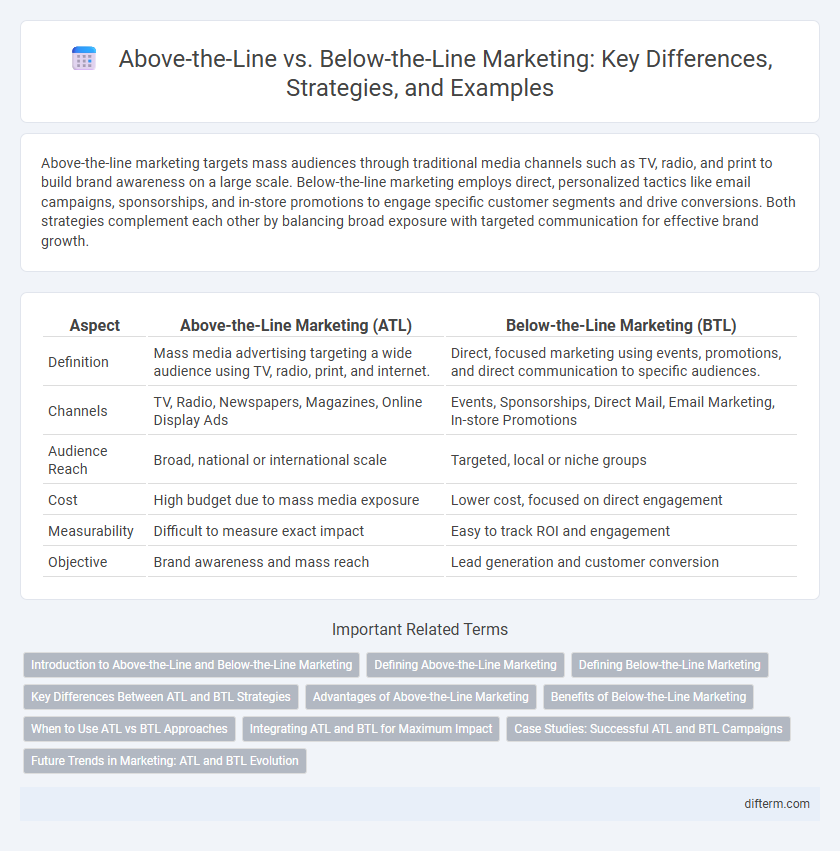Above-the-line marketing targets mass audiences through traditional media channels such as TV, radio, and print to build brand awareness on a large scale. Below-the-line marketing employs direct, personalized tactics like email campaigns, sponsorships, and in-store promotions to engage specific customer segments and drive conversions. Both strategies complement each other by balancing broad exposure with targeted communication for effective brand growth.
Table of Comparison
| Aspect | Above-the-Line Marketing (ATL) | Below-the-Line Marketing (BTL) |
|---|---|---|
| Definition | Mass media advertising targeting a wide audience using TV, radio, print, and internet. | Direct, focused marketing using events, promotions, and direct communication to specific audiences. |
| Channels | TV, Radio, Newspapers, Magazines, Online Display Ads | Events, Sponsorships, Direct Mail, Email Marketing, In-store Promotions |
| Audience Reach | Broad, national or international scale | Targeted, local or niche groups |
| Cost | High budget due to mass media exposure | Lower cost, focused on direct engagement |
| Measurability | Difficult to measure exact impact | Easy to track ROI and engagement |
| Objective | Brand awareness and mass reach | Lead generation and customer conversion |
Introduction to Above-the-Line and Below-the-Line Marketing
Above-the-line (ATL) marketing targets mass audiences through traditional media channels like television, radio, and print advertisements to build widespread brand awareness. Below-the-line (BTL) marketing focuses on direct, targeted strategies such as promotions, events, and direct mail to engage specific customer segments and drive immediate conversions. Both approaches complement each other, forming an integrated marketing communication strategy that balances broad reach with personalized engagement.
Defining Above-the-Line Marketing
Above-the-line (ATL) marketing employs mass media channels such as television, radio, newspapers, and online advertisements to reach a broad audience and create widespread brand awareness. It focuses on building brand identity and driving customer engagement through impactful, high-reach campaigns, often measured by metrics like reach, frequency, and gross rating points (GRPs). ATL is ideal for companies aiming to establish market presence and generate large-scale demand quickly.
Defining Below-the-Line Marketing
Below-the-line marketing (BTL) targets specific audiences through direct, non-mass media channels such as events, direct mail, sponsorships, and in-store promotions. This strategy emphasizes personalized engagement and measurable results, often leveraging digital tools and experiential campaigns to build brand loyalty. BTL marketing enables businesses to tailor their messaging for niche markets, improving conversion rates and customer retention.
Key Differences Between ATL and BTL Strategies
Above-the-line (ATL) marketing relies on mass media channels such as television, radio, and print to build broad brand awareness and reach large audiences, whereas below-the-line (BTL) marketing targets specific customer segments through direct, personalized tactics like events, sponsorships, and in-store promotions. ATL strategies prioritize wide visibility and brand positioning, while BTL focuses on engagement, conversion, and measurable responses from consumers. The distinction lies in ATL's broad reach versus BTL's targeted approach, shaping campaign goals, budget allocation, and performance metrics in marketing planning.
Advantages of Above-the-Line Marketing
Above-the-line marketing leverages mass media channels such as television, radio, and print to reach a broad audience, significantly increasing brand visibility and awareness. This strategy enables consistent messaging across diverse demographics, enhancing customer recall and driving large-scale campaign impact. Its wide reach and ability to build brand equity quickly make it a powerful tool for market penetration and product launch success.
Benefits of Below-the-Line Marketing
Below-the-line (BTL) marketing offers highly targeted and personalized campaigns that directly engage specific customer segments, improving conversion rates. It allows businesses to track performance accurately through measurable actions like coupon redemptions and event attendance, enabling better ROI analysis. BTL marketing fosters stronger customer relationships by creating interactive experiences that enhance brand loyalty and customer retention.
When to Use ATL vs BTL Approaches
Above-the-line (ATL) marketing is effective for brand awareness and mass-market campaigns, utilizing channels like TV, radio, and print to reach a broad audience efficiently. Below-the-line (BTL) marketing works best for targeted promotions, direct customer engagement, and driving immediate responses through tactics such as events, direct mail, and in-store activities. Choosing between ATL and BTL depends on campaign goals, budget, and audience segmentation, with ATL suited for wide reach and BTL optimized for personalized interactions and conversions.
Integrating ATL and BTL for Maximum Impact
Integrating Above-the-line (ATL) and Below-the-line (BTL) marketing strategies amplifies brand visibility and deepens consumer engagement by combining mass media outreach with targeted, personalized campaigns. Leveraging ATL channels like television, radio, and print alongside BTL tactics such as direct mail, events, and digital marketing creates a cohesive brand narrative that drives higher conversion rates and customer loyalty. Data-driven insights enable marketers to optimize the synergy between ATL and BTL efforts, ensuring maximum impact across diverse audience segments.
Case Studies: Successful ATL and BTL Campaigns
Case studies reveal that Nike's "Just Do It" campaign exemplifies above-the-line (ATL) marketing, leveraging mass media channels like TV and billboards to build brand awareness globally. Conversely, Coca-Cola's "Share a Coke" campaign demonstrates below-the-line (BTL) marketing success by using personalized packaging and social media engagement to create direct consumer interaction and boost sales locally. These examples highlight how integrating ATL's broad reach with BTL's targeted approach can enhance overall marketing effectiveness.
Future Trends in Marketing: ATL and BTL Evolution
Above-the-line (ATL) marketing leverages mass media channels like TV, radio, and print to build brand awareness, while below-the-line (BTL) marketing focuses on targeted, direct engagement through digital ads, events, and personalized campaigns. Future trends indicate a convergence of ATL and BTL strategies driven by advanced data analytics, AI-powered personalization, and programmatic advertising, enabling marketers to optimize reach and ROI simultaneously. The evolution emphasizes integrated campaigns that combine broad brand messaging with precise consumer targeting, leveraging cross-channel insights for enhanced marketing effectiveness.
Above-the-line marketing vs below-the-line marketing Infographic

 difterm.com
difterm.com